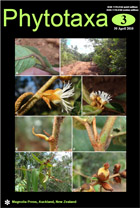Abstract
Impatiens walleriana Hook.f. in Oliver (1868: 302).
Protologue: “Mozambique District, Moramballa, 2000 ft., on stones in streams”. Syntypes: J. Kirk s.n. (K!); H. Waller
s.n. (K!).
Lectotype (designated here): Mozambique, Moramballa, 0-3000 ft., Zambesi Expedition, H. Waller s.n. (K!-000419538).
Notes: The name was published as ‘Walleriana’, which according to the ICBN (McNeill et al., 2006) is not a correctable
error. The species is sometimes erroneously cited as ‘I. wallerana’. The other syntype, J. Kirk s.n. (K!), is also the
holotype of Impatiens sultanii Hooker (1882: t. 6643), a synonym.
The well-known bedding plant ‘busy lizzie’, Impatiens walleriana (Balsaminaceae), is a species occurring naturally in East Africa, where it can be found locally abundant in Kenya, Tanzania and Mozambique. It is frequently associated with wet or humid habitats and can thus be found near streams, waterfalls and in gorges or in the understorey of wet forests. Elsewhere in the tropics and subtropics the species can commonly be found naturalised along roads, in secondary forests and other disturbed habitats, where it can form dominant stands, competing out other species (Richardson et al. 2000, Tabak & Wettenberg 2008).

